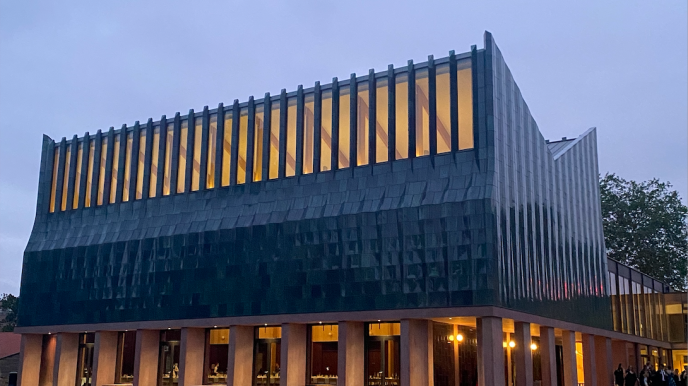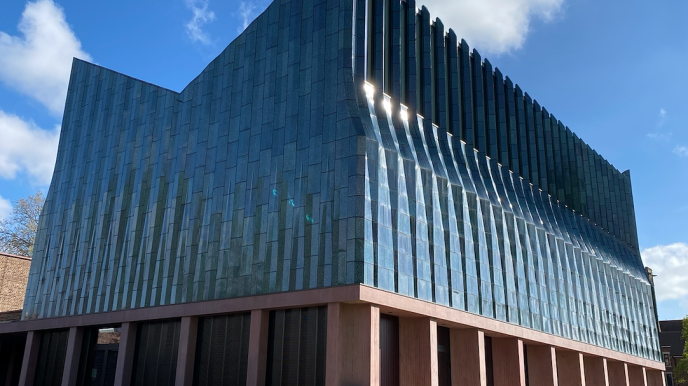The Royal Academy of Arts’ 2023 Summer Exhibition features Homerton’s New Dining Hall (NDH). The Exhibition’s Architecture Room was curated this year by new RA Fellow Peter Barber. Heralded by the Architects Journal as ‘the liveliest for years’, the theme of the room this year is construction and making. Barber has taken as his starting point the sociologist Richard Sennett’s assertion that making is thinking. This provokes visitors to think about both the practical skills and the technical expertise of design professionals. The exhibition catalogue observes that the objects featured are therefore not only a product of the mind but also the hand. This year the Large Weston Room at the RA is painted an eye-catching deep green and is packed with a fascinating selection of what we might call kinetic work: models and objects of varying shapes and sizes. Visitors can see ceramics and tapestries and even a new building material made from bio-waste called Sugar-crete!
Amongst this eclectic selection of ‘analogue’ objects is a timber joint from Homerton’s NDH. The NDH opened in 2022 and was designed by Edmund Fowles and Eleanor Hedley of Stirling Prize-nominated firm Feilden Fowles, alongside Peter Laidler and Sophie Frith of the structural engineering firm Structure Workshop. The joint on display at the RA was created by Peter and Sophie. Displaying the timber joint in its expanded form shows the intricate composition of the hall’s now-iconic timber frame.
The NDH’s frame is a design feature of the hall and is clearly visible inside the building. The ‘bow-tie’ shape that is formed when the beams cross is formed by several very carefully created joints. A bespoke bridle joint with two tenons forms the centre of the timber frame and this ‘butterfly’ form is unique. This centre ‘butterfly’ is the joint that is on display at the RA. Another bridle joint can be found at the eaves and the heel is held with a mortise and tenon. All the joints are pegged with timber pegs. Visitors to the RA can see in the expanded butterfly joint on display the way in which the pegs fit into the timbers to create the joint, removing the need for structural steel.
During the design phase, the joints and the frame were subject to extensive testing through model making. The models and sections reveal the progression of the design and now form an archive of those revolutions in mind and hand that led to the building as we see it today. The butterfly joint on display at the RA is made from ethically-sourced Douglas Fir wood. After interrogation of the timber supply chain, the frame of the NDH was made in ethically-sourced Spanish sweet chestnut. The joint on display at the RA therefore offers a glimpse of a crucial moment in the NDH’s creation where the concept work of the building begins to come to life.
Described by the architects Edmund Fowles and Eleanor Hedley as an ‘arts and crafts building for the 21st century’ the NDH is a pioneering example of the ‘low tech’ architectural approach. Low-tech architecture is a way of rebalancing the relationship between buildings and technology by prioritising the use of natural and low embodied carbon materials. The timber frame contains no structural steel and the low-tech design has resulted in a building which achieves an embodied carbon of just 697 co2e/m2 which is already in line with the Royal Institute of British Architects’ 2025 targets.
Homerton’s NDH has already garnered a number of awards since opening, including several which reward the careful craftsmanship of both mind and hand. At the 2022 Wood Awards, the NDH was awarded the Best Education and Public Building, Best Structural Timber Award and beat over 200 other buildings nationwide to be crowned the overall Gold Winner. Closer to home in Spring 2023, the NDH swept the board once again at the Greater Cambridge Design Awards winning both Best New Building and Craftsmanship Awards. In February 2023, architect Edmund Fowles, Structural Engineer Peter Laidler, and Vice-Principal Francesca Moore were excited to participate in a panel discussion at the FutureBuild conference at the London Excel arena which explored the importance of timber as a construction material.
Homerton’s Vice-Principal Dr Francesca Moore said ‘We are delighted that our new dining hall has been recognised for its outstanding craftsmanship and lean approach. It is an honour to have had a unique timber joint created for our very special building and for this to be featured in the Royal Academy’s Summer Exhibition. The meticulous climate-aware design and carefully sourced materials of the New Dining Hall have ensured that the college’s values are embodied in the estate. The college would like to thank the project team for this exceptional new building.’
All photos taken by Francesca Moore.












